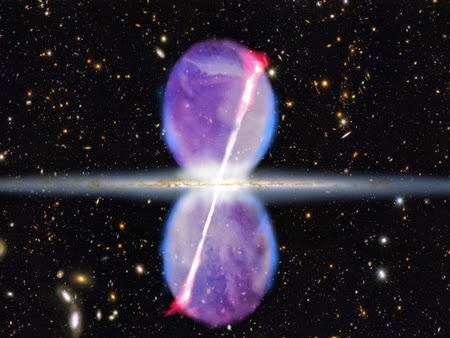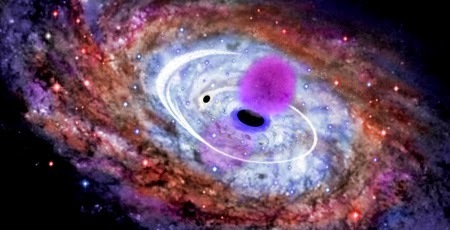Blowing Bubbles at the Centre of our Galaxy
 Fermi Bubbles of our Milky WayIn
Outer Diverse
, the first book of the space thriller trilogy The Splintered Universe, Detective Rhea Hawke travels through the dangers “breathing” galaxies and dark matter in her quest for justice:
Fermi Bubbles of our Milky WayIn
Outer Diverse
, the first book of the space thriller trilogy The Splintered Universe, Detective Rhea Hawke travels through the dangers “breathing” galaxies and dark matter in her quest for justice:When I’d joined up as an Enforcer, the Guardians gave me my own starship, a rare ray-class retro Earth/alien design that no one else wanted. It didn’t matter to me. Benny was mine. Thanks to Benny’s plasma shields, we’d weathered treacherous ionic storms, gamma-ray bursts, and the high-velocity clouds of the breathing galaxy. We jacked the Magellanic Stream and travelled to the farthest arms of the spiral galaxy, surfing scalar fields into thrilling particle stream shortcuts. We’d even slingshot our way around the black hole in the galactic core using its immense gravitational field and high-energy emissions. I’d witnessed many galactic wonders like the terrifying beauty of nebulas: tangled filaments of dust and ionized gas that poured out in jets and waves from the stellar corpse of a neutron star. Pulsing electromagnetic energy, the shock wave of material flung from the supernova created a spectacular lightshow that shredded anything in its path, drawing me into breathless wonder …
The stuff of science fiction isn’t always fiction. Was Rhea Hawke talking about the Fermi
 Bubbles? Gigantic gamma-ray “bubbles”, stretching thousands of light-years north and south from the galactic centre of the Milky Way…
Bubbles? Gigantic gamma-ray “bubbles”, stretching thousands of light-years north and south from the galactic centre of the Milky Way… About four years ago, NASA revealed an incredible structure discovered by astronomers at their Fermi Gamma-ray Space Telescope. Spanning 50,000 light-years and extending north and south of the Milky Way’s centre like a giant infinity symbol, the gargantuan gamma ray bubbles—now called the Fermi Bubbles—are speculated to be the remnants of an eruption from a supersized black hole at the centre of our galaxy.
“The outlines of the bubbles are quite sharp, and the bubbles themselves glow in nearly uniform gamma rays over their colossal surfaces, like two 30,000-light-year-tall incandescent bulbs screwed into the center of the galaxy,” Stanford scientists and the Department of Energy's SLAC National Accelerator Laboratory reported in an April 2014 paper in The Astrophysical Journal. Their size is another puzzle. The farthest reaches of the Fermi bubbles contain some of the highest energy gamma rays, but there's no discernable cause for them that far from the galaxy. Another difference from other galactic bubbles is that the parts of the bubbles closest to the galactic plane shine in microwaves as well as gamma rays, but at about two-thirds of the way out, the microwaves fade out and only gamma rays are detectable.
 “Gamma rays are the bad boys of the electromagnetic spectrum—the highest energy light in the universe,” says Bob Berman of the Almanac Weekly. “Because of this, they do not reliably reflect off objects the way that visible light does. Rather, they are penetrating. Such photons drill through bodies at the speed of light, damaging chromosomes all along the way.” The hour-glass shaped structure spans more than half of the visible sky, from the constellation Virgo to the constellation Grus, and it may be millions of years old.
“Gamma rays are the bad boys of the electromagnetic spectrum—the highest energy light in the universe,” says Bob Berman of the Almanac Weekly. “Because of this, they do not reliably reflect off objects the way that visible light does. Rather, they are penetrating. Such photons drill through bodies at the speed of light, damaging chromosomes all along the way.” The hour-glass shaped structure spans more than half of the visible sky, from the constellation Virgo to the constellation Grus, and it may be millions of years old.Doug Finkbeiner and his team at the Harvard-Smithsonian Center for Astrophysics in Cambridge, Mass discovered the bubbles by processing publicly available data from Fermi's Large Area Telescope (LAT). The LAT is the most sensitive and highest-resolution gamma-ray detector ever launched.
The bubble emissions have a well-defined shape and are much more energetic than the gamma-ray fog seen elsewhere in the Milky Way, suggesting that it was formed from a large and rapid energy release - the source of which remains a mystery.
“Fortunately, few gamma rays reach us here at Earth’s surface,” Berman continues. “Stars
 A giant "burp" from a black hole...?usually don’t emit them, and in any case our atmosphere blocks them. The only gamma rays flying near Earth have come from distant violent events like supernovae. This is why a dense gamma-ray swarm at our own galaxy’s center is so puzzling. It’s the unmistakable sign of extreme violence. And yet, these days, the Milky Way’s core is about as energetic as a steamy Florida lunchtime.”
A giant "burp" from a black hole...?usually don’t emit them, and in any case our atmosphere blocks them. The only gamma rays flying near Earth have come from distant violent events like supernovae. This is why a dense gamma-ray swarm at our own galaxy’s center is so puzzling. It’s the unmistakable sign of extreme violence. And yet, these days, the Milky Way’s core is about as energetic as a steamy Florida lunchtime.”What Blew the Bubbles?
NASA speculates that the bubbles could have been created by huge jets of accelerated matter blasting out from the supermassive black hole at the center of our galaxy. Or they may have formed as gas outflows from a burst of star formation, perhaps the one that created the massive star clusters in the Milky Way's center several million years ago.
"In other galaxies, we see that starbursts can drive enormous gas outflows," said David Spergel, a scientist at Princeton University in New Jersey. "Whatever the energy source behind these huge bubbles may be, it is connected to many deep questions in astrophysics."
Berman asks, “Might these be the long-sought signs of dark matter? Could dark matter be meeting its opposite entity (whatever that is) in total annihilation, the way that matter and antimatter do?” As Fermi research team leader Douglas Bookbeiner put it, “This just confuses everything.” Except the science fiction writers (smug grin).
For more information about Fermi, visit:
http://www.nasa.gov/fermi
 Nina Munteanu
is an ecologist and internationally published author of novels, short stories and essays. She coaches writers and teaches writing at George Brown College and the University of Toronto. For more about Nina’s coaching & workshops visit
www.ninamunteanu.me
. Visit
www.ninamunteanu.ca
for more about her writing.
Nina Munteanu
is an ecologist and internationally published author of novels, short stories and essays. She coaches writers and teaches writing at George Brown College and the University of Toronto. For more about Nina’s coaching & workshops visit
www.ninamunteanu.me
. Visit
www.ninamunteanu.ca
for more about her writing.
Published on December 04, 2014 15:18
No comments have been added yet.



